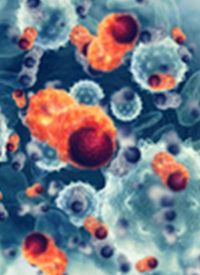Article
RG6234 Is Highly Active in Relapsed/Refractory Multiple Myeloma
Author(s):
RG6234, a novel T-cell engaging bispecific antibody with a 2:1 configuration, induced high response rates and early evidence of durability for patients with relapsed/refractory multiple myeloma.

RG6234, a novel T-cell engaging bispecific antibody with a 2:1 configuration, induced high response rates and early evidence of durability for patients with relapsed/refractory multiple myeloma, according to findings from a first-in-human study (NCT04557150) presented at the 2022 EHA Congress.1
Fifty-one patients received at least one target dose of RG6234 as of the April 5, 2022, data cutoff; 42 were evaluable for efficacy. The overall response rate was 71.4% with complete response (CR) and stringent CR rates of 11.9% each. The very good partial response or better rate was 52.4%. Twenty-five of 30 patients (83.3%) had ongoing response with a maximum duration of response of 11 months.
RG6234 targets GPRC5D, a novel surface receptor. Overexpression of the protein in bone marrow has been linked with poor prognosis for patients with multiple myeloma.2
In this ongoing phase 1 dose-escalation and -expansion study, patients received RG6234 in escalating weekly step-up doses, followed by a peak target dose administered every 2 weeks for up to 1 year. Eligible patients in the dose-escalation phase previously received therapy with an immunomodulatory drug (IMiD) and proteasome inhibitor (PI) and were intolerant to or had no other option for standard-of-care treatment. In the dose-expansion phase, eligible patients received at least 3 prior treatments and were refractory to an IMiD, a PI, and a CD38-targeted therapy.
As of January 31, 2022, 41 patients had received RG6234 doses of 0.006 mg to 10 mg.
The median patient age was 63 years (range, 27-78). Sixty-one percent of patients had stage II or III disease at baseline as assessed by the Revised Multiple Myeloma International Staging System. Seventeen of 29 evaluable patients displayed high-risk cytogenetics.
Patients had received a median of 5 (range, 2-15) prior therapies. Sixty-seven percent were triple-class refractory and 36% were penta-class refractory. Six (14.6%) patients had previously received BCMA-directed therapy.
The study’s primary end points were safety, tolerability, maximum tolerated dose (MTD), and recommended phase 2 dose. Secondary end points included pharmacokinetics, pharmacodynamics, immunogenicity, and clinical activity.
Fifty-one patients were included in the safety analysis; 47 (92.2%) experienced a treatment-related adverse effect (TRAE) of any grade. Investigators recorded grade 3/4 TRAEs in 33.3% of patients. Twenty-two (43.1%) patients experienced serious TRAEs, but there were no grade 5 TRAEs recorded.
The most common grade 3 or higher AEs were hematologic (25.5%), infections (17.6%), and skin reactions (9.8%). Investigators said AEs were consistent with observations with other bisphosphonates and drugs targeting GPRC5D.
Four (7.8%) patients required dose reduction, 2 (3.9) of which were related to RG6234. Three (5.9%) patients discontinued treatment, 1 (2.0%) due to the study drug.
Forty (78.4%) patients experienced any-grade cytokine release syndrome (CRS). Just 1 (2.0%) patient experienced grade 3 CRS, and there was no grade 4/5 CRS recorded. No patients discontinued treatment because of CRS.
The median time to CRS onset from last dose was 5 hours (range, 0-64). The median CRS duration was 2 days (range, 1-8). Investigators managed CRS with corticosteroids (52.9%) or tocilizumab (Actemra; 37.3%). Investigators concluded that step-up dosing limited the risk for severe CRS.
References
- Hasselbalch Riley C, Hutchings M, Yoon SS, et al. RG6234, a novel GPRC5D T-cell engaging bispecific antibody, induces rapid responses in patients with relapsed/refractory multiple myeloma: preliminary results from a first-in-human trial. Presented at: 2022 EHA Congress; June 9-12, 2022; Vienna, Austria. Abstract S180.
- Atamaniuk J, Gleiss A, Porpaczy E, et al. Overexpression of G protein-coupled receptor 5D in the bone marrow is associated with poor prognosis in patients with multiple myeloma. Eur J Clin Invest. 2012 Sep;42(9):953-960. doi:10.1111/j.1365-2362.2012.02679.x






%20(2)%201-Recovered-Recovered-Recovered-Recovered-Recovered.jpg?fit=crop&auto=format)
%20(2)%201-Recovered-Recovered-Recovered-Recovered-Recovered.jpg?fit=crop&auto=format)

